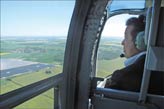Harbin-ger of change
Updated: 2011-06-03 11:37
By Lu Chang and Tian Xuefei (China Daily European Weekly)
The establishment of the joint venture is viewed as a result of Airbus' commitment to manufacture 5 percent of the A350 airframe in China under an agreement reached in 2007 with the Chinese government and a confirmation of Harbin's growing technology and distinct advantages in the aviation sector.
|
 |
"Hafei has a long history in aviation manufacturing and it has vast composites application expertise for the development of commercial airplanes and helicopters," says Jose A. Veroz, general manager of the joint venture, the Harbin Hafei Airbus Composite Manufacturing Center.
"Besides, there are many technological universities and research institutes such as Harbin's Institute of Technology, which will supply us with many smart and experienced workers and engineers."
Veroz says the delivery of the first parts proves the capabilities of the manufacturing center in producing composite components.
With the A350 ramping up work, the company will need 600 employees in the manufacturing center by 2016.
The A350, Airbus' answer to the runaway success of US rival Boeing's B787, has received 860 orders for long-range, twin-aisle planes due to enter service in 2013.
China signed a letter of intent in 2006 to buy 20 A350s and Airbus had received 505 orders by the end of March.
Airbus is not the only foreign aviation manufacturer to cooperate with Hafei. As Harbin steps up efforts to become a major player in the sector, other global leading trunk line aviation manufacturers such as Boeing, Embraer, Brazil's airplane conglomerate, and a number of helicopter producers are scrambling to take advantage of the potential growth in the Chinese market.
|
 |
Wang Xia, deputy president of the General Aviation College under the Civil Aviation University of China, says the construction of the joint venture is significant for expanding the strength of the aircraft manufacturing industry in Harbin, boosting the technical advantages in research and development of the aviation of Hafei and China, and stimulating the country's aviation industry to integrate into the world aviation industrial chain.
"The development of the whole industry will be accelerated by cooperating with foreign companies and introducing advanced technologies to provide industrial and management know-how and develop China's own products," Wang says.
"More importantly, it will help Harbin attract investment from other aviation-related companies for long-term impact on the future development of Harbin as an economic center of Northeast China."
Apart from the aircraft industry, the city has to date implemented key science and technology projects that aim to strengthen its innovation capacity of a wide range of industries.
The Science and Technology Department of Heilongjiang earmarked 20 million yuan (2.14 million euros) in 2009 to set up a special fund to support small- and medium-sized companies in new product research and development.
In 2008 the province initiated an incentive package including advantageous tax allowances and dispensations over land use.
The incentives, coupled with central government support, have already generated high-tech industry strong growth this year.
In the first quarter of 2011, Harbin's high-tech industrial output value reached 56.3 billion yuan, increasing 27 percent from a year ago and accounting for a big chunk of the city's total GDP.
Growth of the software outsourcing sector was even more dramatic - with its combined sales revenues growing 54 percent compared to the previous year.
High technologies are now widely used in sectors like energy, modern equipment manufacturing, aviation, pharmaceuticals, food processing and new materials.
"High-tech is playing an increasingly important role in revitalizing Heilongjiang's traditional industries and fostering emerging industries," says Ji Bingxuan, Party chief of the province.
"Though we are already beginning to see the benefits, we are going to continue to give more support to stimulate growth across these sectors, since we still have a long way to go."
E-paper

Harbin-ger of change
Old industrial center looks to innovation to move up the value chain
Chemical attraction
The reel Mao
Improving app-iness
Specials

Vice-President visits Italy
The visit is expected to lend new impetus to Sino-Italian relations.

Birthday a new 'starting point'
China's national English language newspaper aims for a top-notch international all-media group.

Sky is the limit
Chinese tycoon conjures up green dreams in Europe with solar panels
